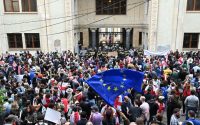Haim Roet, Who Kept Holocaust Victims’ Names Alive, Dies at 90
Rosina Roet. Adelheid Roet. Abraham Prince.
The names of those three Dutch Jews and others who died in the Holocaust could have easily been lost to history, their individual humanity snuffed out under the overwhelming weight of six million victims.
Haim Roet, a relative, ensured that this never happened.
Mr. Roet, who survived the Holocaust by hiding in a Dutch village, came up with the simple but powerful idea of memorializing Jewish victims of the Nazis by intoning their names.
“I tried to find a way to make the Holocaust more personal, so people can understand the calamity of six million souls murdered for being Jewish,” he said in a speech before the United Nations in 2016.
Mr. Roet died on May 22 at his home in Jerusalem, his daughter Vardit Lichtenstein said. He was 90.
Mr. Roet created Unto Every Person There is a Name, a memorial project that involves annually reading the names of Nazi victims in public around the world.
Mr. Roet (pronounced “root” in Dutch and “rote” in Hebrew) said he first recited the names of Holocaust victims in 1989, after the Dutch government decided to release two Nazi war criminals, Ferdinand Aus der Funten and Franz Fischer, from their life sentences. Mr. Aus der Funten and Mr. Fischer had been instrumental in the extermination of thousands of Dutch Jews.
Mr. Roet and a group of like-minded Israelis of Dutch descent organized a protest in front of the Dutch Embassy in Tel Aviv, at which they read some of the names of the 107,000 Dutch Jews who had died in death camps.
“It was a very moving event,” Mr. Roet said in Hebrew in a video posted on YouTube by Yad Vashem, the Israeli organization dedicated to documenting and commemorating the Holocaust. “People cried.”
“You see the names, and suddenly you see what’s behind it,” he continued. “You see the date, you see the children, how each of the victims had a life of their own, and I thought: We always talk about six million people. Maybe on Holocaust Memorial Day we should make it more personal by reading the names of every victim.”
Mr. Roet worked to spread the idea, and during the early 2000s, Yad Vashem and the Knesset, Israel’s parliament, made reading the names of victims an integral part of ceremonies on Yom HaShoah, or Holocaust Remembrance Day.
Similar ceremonies are conducted in hundreds of Jewish communities around the world, organized by Yad Vashem and Jewish organizations like B’nai B’rith International, the World Jewish Congress and the World Zionist Organization. Other memorial ceremonies, like the annual 9/11 commemoration, also include the recitation of victims’ names.
Haim Roet was born Hendrik Roet in Amsterdam on July 10, 1932, the youngest of six children of Shlomo Roet and Johanna Prince-Roet. He was 7 years old when the Nazis invaded the Netherlands in 1940.
In 1942, his family was sent to live for a week in a Jewish theater, where more than a thousand Jews were held before being sent to concentration camps. For reasons that are unclear, the Roet family ended up in a ghetto instead, where his grandfather Abraham lived in a small apartment with his sisters, Rosina and Adelheid, near one for his parents and the family’s four boys.
In September 1943, SS officers came for his grandfather and sisters. His grandfather died in the gas chamber at Auschwitz; his sister Rosina died of typhus at the camp; his sister Adelheid, her health destroyed by years in concentration camps, died shortly after liberation.
“We never saw my sisters or grandfather ever again,” Mr. Roet said at the U.N. in 2016.
The next morning, the SS officers returned for the rest of the family. But his mother, who spoke German, shouted and argued with them so vehemently that they left, Mr. Roet later recalled.
His parents contacted the Resistance, which found hiding places for the family. Hendrik wound up in Nieuwlande, a small village in the Netherlands that sheltered more than 100 Jews during the war despite the threat of execution by the Nazis.
He lived with Alida and Anton Deesker, who had three children and introduced him to strangers as their nephew. Existence was perilous — one unlucky police patrol could have meant the end — but the Deeskers still took in two more Jews, a mother and her grown son.
After liberation, a neighbor noticed signs from the Red Cross that said Mr. Roet’s parents were looking for their children. In time, they found one another.
“A year and a half after being torn from my family, thinking I was all alone in the world, I was reunited in the middle of the night with my parents and my three surviving brothers,” Mr. Roet said in 2016.
In 1949, he settled in Israel and began using his Hebrew first name, Haim. His parents came a few years later. In 1958, he married Naomi Echel.
Mr. Roet worked for the Israeli Ministry of Finance and what is now the Ministry of Economy and Industry, and for the World Bank in Washington. He also became immersed in Holocaust memorial efforts.
Determined to increase the official recognition of Jews who helped other Jews survive the Nazis, he was founder and chairman of a nonprofit dedicated to honoring them, the Committee to Recognize the Heroism of Jewish Rescuers During the Holocaust.
In addition to his daughter Ms. Lichtenstein, the vice president of an obstetrics and gynecology group, Mr. Roet is survived by his wife; another daughter, Avigail Omessi, an account manager for an accounting firm; a son, David Roet, the deputy director general and head of the North America division of Israel’s Ministry of Foreign Affairs; a brother, Abraham; eight grandchildren; and two great-grandchildren.
One of Yad Vashem’s major initiatives is gathering the names of as many Holocaust victims as possible. So far it has amassed almost five million.
“It is so important to gather the names,” Mr. Roet said in the Yad Vashem video, “so they don’t remain anonymous, and that each one of them will be remembered, and have a certain place — if not in a physical grave, at least a grave within our memory and the memory of the Jewish people.”
Sheelagh McNeill contributed research.


